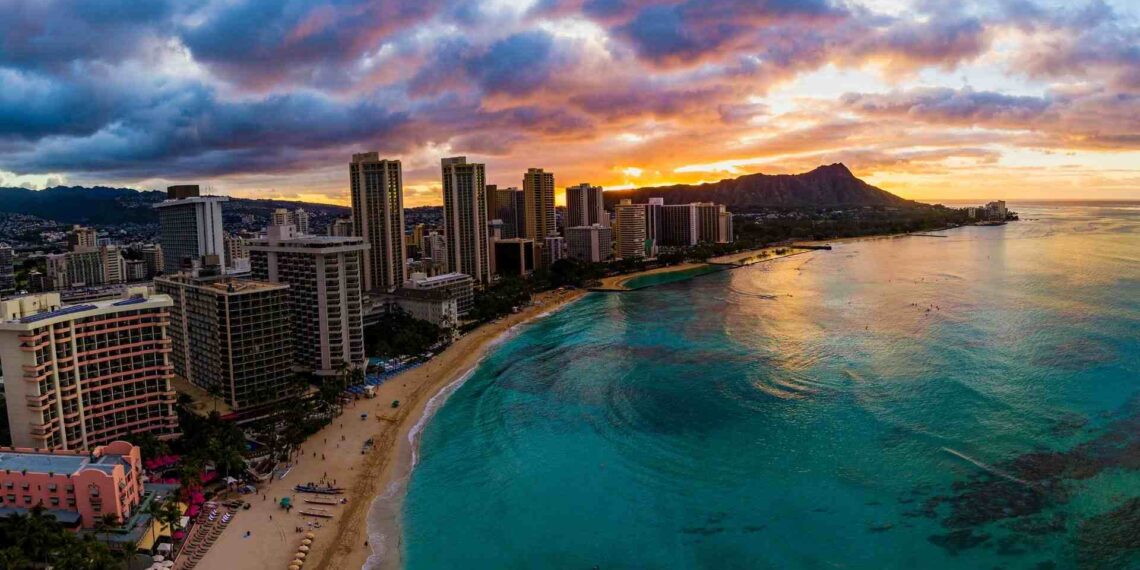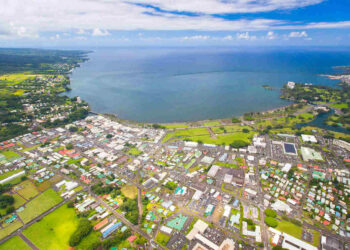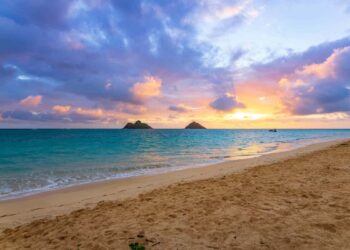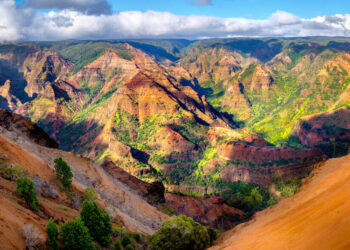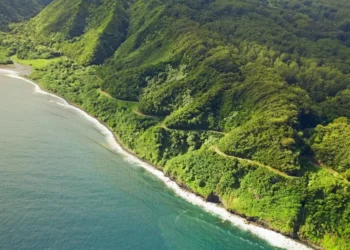Waikiki Beach stretches along the southern shore of Oahu, a ribbon of sand cradled by the Pacific and framed by the ancient rise of Diamond Head. Once a retreat for Hawaiian royalty, this coastal expanse has grown into a place where history meets the hum of modern life. The waves roll in steady and gentle, the air carries a hint of salt and bloom, and the horizon holds a promise of calm. For those seeking a blend of natural beauty and human energy, Waikiki stands as a cornerstone of Hawaii’s allure. This guide offers a clear look at what makes it worth the journey, grounded in observation and fact.
Notable Insight: A Royal Legacy
Waikiki’s name comes from Hawaiian words meaning “spouting waters,” a nod to the springs and streams that once fed its wetlands. In the 19th century, it was a playground for ali’i—Hawaiian chiefs—who paddled canoes and surfed its swells. Today, a statue of Duke Kahanamoku, the father of modern surfing, stands near the shore, his arms outstretched, a quiet tribute to the sport’s roots here.
Places to Visit: An Overview
Waikiki Beach isn’t one thing—it’s a collection of stretches and sights, each with its own pull. The main beach runs two miles, split into sections like Kuhio and Queen’s Beach, where the water’s shallow enough for wading or learning to surf. Beyond the sand, the Honolulu Zoo sits a short walk east, its 42 acres home to komodo dragons and pacing tigers. Next door, the Waikiki Aquarium peers into the sea’s depths, with tanks of reef fish and monk seals that glide like shadows. Up the coast, the Ala Wai Canal marks the northern edge, a calm waterway where paddleboarders drift past city lights. And towering above it all, Diamond Head’s trail climbs to a crater rim, offering a view that sweeps from Waikiki to the open ocean.
The Waikiki Historic Trail ties it together, a path marked by surfboard signs that point to spots like the Moana Hotel, opened in 1901 as the first of its kind here. Each stop tells a piece of the story—how this swampy shore turned into a global draw. If time allows, the nearby Ala Moana Center offers a break from the sun, its open-air halls packed with shops and food stalls.
How to Reach
Getting to Waikiki starts with Oahu’s main gateway, Daniel K. Inouye International Airport in Honolulu, just six miles west. Flights land from cities like Los Angeles or Tokyo, a 5- to 8-hour haul depending on your start. From the terminal, options fan out. Taxis or rideshares like Uber roll straight to Waikiki in 15-20 minutes, fares hovering around $25-$35, traffic depending. TheBus, Oahu’s public line, runs Route 19 or 20 from the airport to the beach for $3, a slower ride—45 minutes or so—but steady. Rental cars work too; take H-1 East, then exit at Punahou Street, and you’re there in a straight shot. Parking’s tight, though—hotels charge $30-$50 a day, and street spots vanish fast.
If you’re island-hopping, ferries don’t connect Oahu to neighbors like Maui, so book a quick flight—30 minutes tops—or plan your whole stay here. Once in Waikiki, it’s walkable; the beach, shops, and trails are close, though a bike rental from Biki stations ($4 for 30 minutes) stretches your range.
Experiencing Waikiki Beach
The Shoreline
The beach itself is the heart. The sand’s soft, raked daily, and the water’s warm—75°F year-round—making it a draw for swimming or just standing knee-deep. Surf schools line up near Kuhio Beach, boards ready for $20 an hour, instructors shouting tips over the waves. Further out, outrigger canoes cut through, a nod to the old ways. At sunset, the sky turns orange, and folks gather—some with cameras, some just watching.
Beyond the Sand
Diamond Head’s hike is a must, a 1.6-mile round trip up switchbacks and stairs to a lookout 560 feet high. It takes an hour, maybe two if you stop to breathe, and the top shows Waikiki’s curve against the sea. The zoo’s quieter—peacocks strut free, and the elephant enclosure hums with kids’ voices. The aquarium, small but sharp, has a coral reef tank that feels alive, fish darting in flashes of blue and yellow.
Night and Day
After dark, Kalakaua Avenue lights up—restaurants spill onto sidewalks, and live music drifts from bars like Duke’s Waikiki, where hula dancers sway to steel guitars. Daytime’s for the water or the trail; pick a morning to walk the Historic Trail’s 20 stops, reading plaques about kings and surfers who shaped this place.
Frequently Asked Questions About Waikiki Beach
Is it crowded year-round?
Yes, mostly. Summer and winter holidays pack it tight—think July or December—but spring and fall thin the lines. Early mornings beat the rush; by 10 a.m., towels stake every inch.
What’s the water like for beginners?
Gentle. The breakwall at Kuhio Beach keeps waves low, 2-3 feet, perfect for first-timers. Lifeguards watch year-round, towers spaced every few hundred yards.
Are there hidden costs?
Some. Beach chairs and umbrellas run $50 a day from vendors, and parking’s a sting if you drive. Food’s pricier here—$15 for a plate lunch—but convenience stores like ABC cut that in half.
Can you see wildlife?
Plenty. Green sea turtles pop up near the shore, heads bobbing slow. Reef fish—triggerfish, parrotfish—flit close if you snorkel, though gear’s $10 to rent.
Where to Stay
Moana Hotel
The grand dame of Waikiki, steps from the sand, with rooms blending old wood and clean lines. Ocean views cost extra—$300-$400 a night—but the history’s free.
Hilton Hawaiian Village
A sprawl near the west end, with pools and a lagoon. Rooms start at $250, and the Friday fireworks light up from its beach.
Aqua Oasis
A budget pick off Kalakaua, quiet but central. $150 gets you a bed and a balcony; no frills, just close to the action.
Dining Nearby
Duke’s Waikiki
Barefoot vibes, oceanfront, with fish tacos at $18 and mai tais that hit right. The salad bar’s a steal at $12.
Island Vintage Coffee
A block inland, strong brews for $5 and acai bowls piled high for $14. Morning lines move fast.
Marukame Udon
Cheap and hearty—$8 for a bowl of noodles in broth, steaming hot. It’s a local haunt, cash only.
Final Thoughts
Waikiki Beach holds a piece of Hawaii’s soul—where chiefs once paddled, where Duke rode waves into legend, where the land meets the sea in a steady handshake. It’s not quiet; the hum of people, the slap of water, the call of vendors fill it up. But stand there at dusk, the sun sinking red, and you feel it—a thread from then to now, unbroken. It’s a place that asks you to look, to move, to listen—not just pass through. Whether you surf, hike, or sit with a coffee, Waikiki’s got a story, and it’s waiting for you to hear it.
